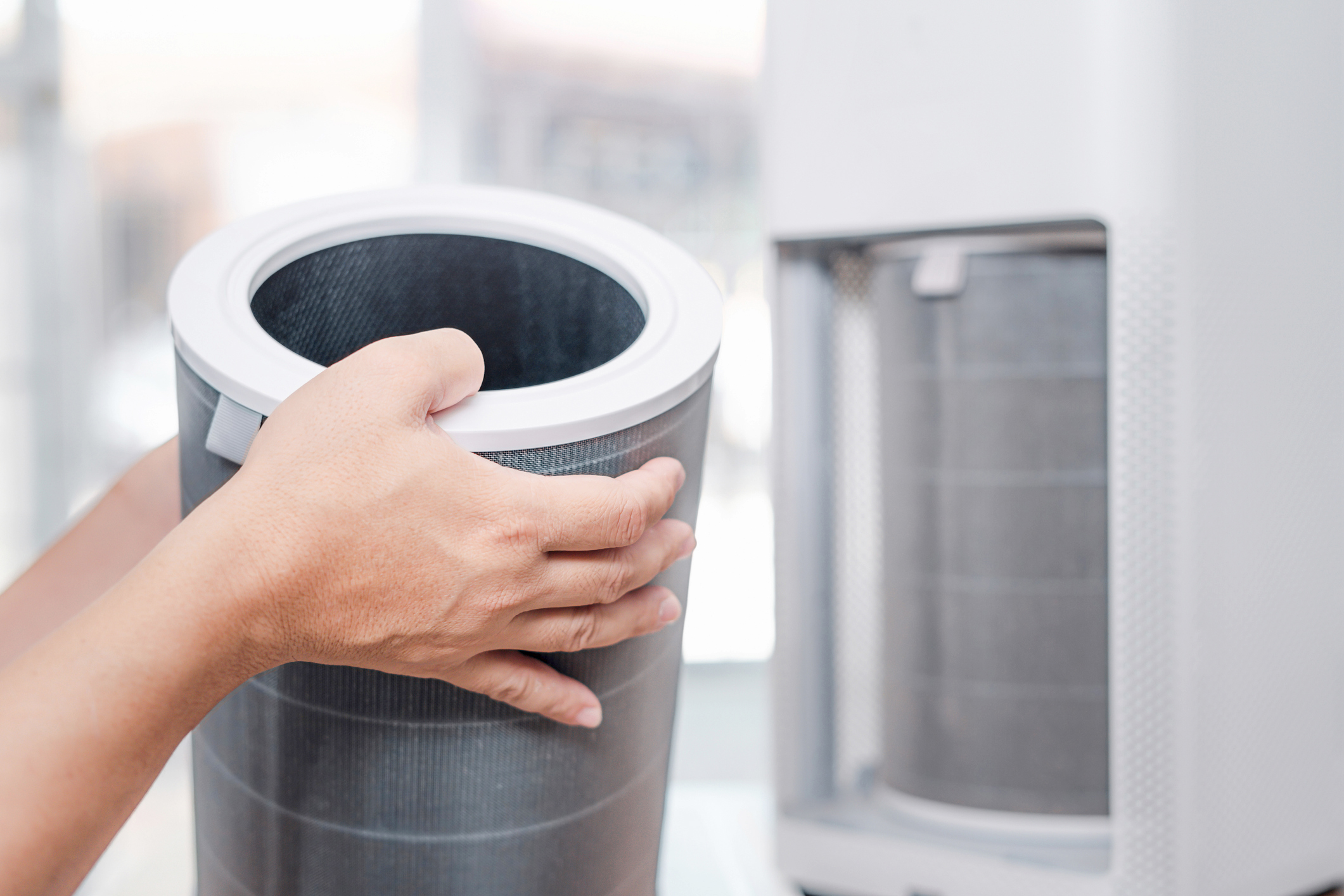
Did you know that there are numerous filters in your home that require regular cleaning? While most people diligently clean their air conditioning or HVAC filters, they often overlook other crucial filters lurking in unexpected places.
These forgotten filters can impact the efficiency and cleanliness of various systems, leading to potential health hazards and increased energy consumption.
In this blog post, we will shed light on the most common filters people forget to clean in their homes. From refrigerator coils to range hood vents, we’ll explore why neglecting these essential maintenance tasks can have significant consequences for your home’s overall well-being.
So let’s dive into the world of overlooked filters and learn how a little extra attention can go a long way in maintaining a healthy living space.
How and When to Clean Appliance Filters at Home
There are many appliances and devices around our homes that are equipped with filters to trap dust, pollen, and other contaminants.
While some need entirely replacements, others are reusable and only need regular cleaning. However, it’s understandable how a person with a fast-paced lifestyle can forget to do it.
Nevertheless, it’s still important to take the time to do it or at least hire professionals to deal with the for you, otherwise, this can result in costly consequences and unhealthy living space.
Some of the most common filters people forget to clean in their homes include:
Coffeemaker Filters
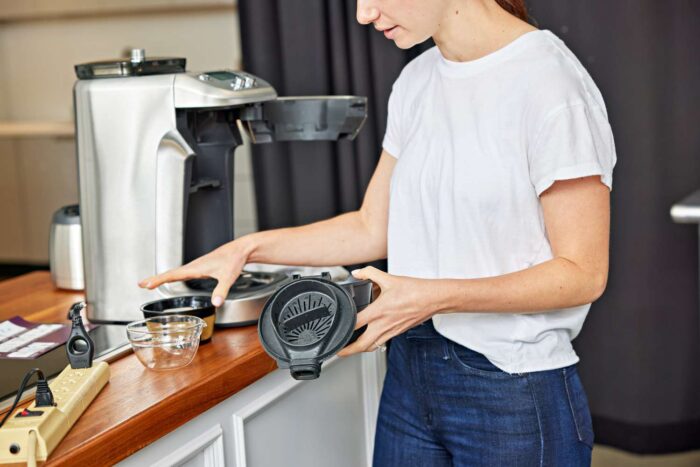
Coffeemaker filters are typically very small, so it’s understandable how people forget to take care of them.
However, cleaning them is an important task to maintain the quality of your coffee and ensure the longevity of your machine.
It’s recommended to clean coffee maker filters at least once a month, although some filters may require more frequent cleaning depending on usage and water quality. When doing that, refer to your coffee maker’s user manual for specific instructions.
How to Clean Coffeemaker Filters?
- First, make sure the coffee maker is unplugged and cooled down. Locate the filter compartment and remove the filter basket or filter holder, depending on the design of your coffee maker.
- Throw out old coffee grounds, or put them in the compost.
- Rinse the basket under warm water to remove any remaining residue. Afterward, fill a basin or sink with warm water and mild dish soap.
- Submerge the filter basket in the soapy water and let it soak for about 15 minutes. This will help remove oils and stains that have accumulated over time.
- After soaking, use a soft brush, sponge, or cloth to gently scrub the filter basket, focusing on any stubborn residue or stains. Pay attention to the tiny holes in the filter to ensure they’re not clogged.
- Clean the filter basket by rinsing it with warm water to get rid of any soap leftovers.
- Ensure that all traces of soap are washed away, otherwise, it can affect the taste of your coffee.
- Finally, place the filter basket on a clean towel or drying rack and let it air dry completely before reassembling and using it again.
If you neglect cleaning your coffeemaker filter regularly, several things can happen.
First, over time, coffee oils and residue can accumulate in the filter, affecting the flavor of your brewed coffee. This can result in a bitter or stale taste that is far from a pleasant coffee experience.
Besides that, neglecting to clean the filters can also lead to clogging of the tiny holes, impeding water flow. This can result in slower brewing times, incomplete extraction of flavors, and potential damage to the machine.
Why Should You Clean Coffeemaker Filers?
Moisture and leftover coffee grounds in the filter can also create an environment for bacterial growth and mold. These contaminants can compromise your health and the cleanliness of your coffee maker.
Regularly cleaning your coffee maker filters will not only ensure a better-tasting cup of coffee but also help maintain the machine’s efficiency and longevity.
Dryer Filters
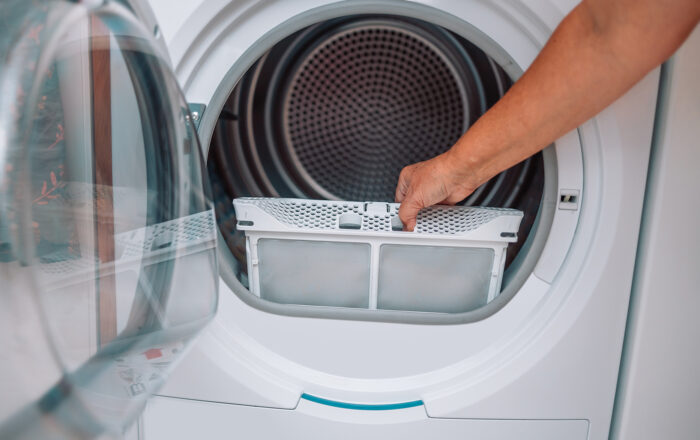
Typically, the plastic mesh and pullout lint catcher in your dryer should be cleaned after taking out every laundry load, otherwise, it can be a fire hazard.
How to Clean Dryer Filters?
- Cleaning them is also crucial for maintaining the efficiency and safety of your dryer. In many cases, the lint filter can be found either inside the dryer door or on the top of the appliance.
- After each use, open the dryer door and locate the lint filter.
- Pull it out of the dryer and remove the lint from the filter by hand or use a soft brush or vacuum cleaner attachment to gently remove the lint buildup.
- Make sure you remove all visible lint and debris.
- Afterward, rinse the filter with mild soap and warm water to remove any residue.
- Allow the part to dry thoroughly before putting it back in the dryer.
It is suggested that the lint filter be cleaned following each drying cycle. Regular cleaning prevents lint accumulation, ensures optimal airflow, and reduces the risk of fire hazards. If you neglect to do that, there can be several consequences.
Why Should You Clean Dryer Filers?
First, lint buildup in the dryer filter is highly flammable. If the filter becomes clogged with lint, the risk of a dryer fire significantly increases. Lint is a leading cause of household fires, so regular cleaning is vital to reduce this risk.
Second, a clogged dryer filter restricts the airflow, making the dryer work harder and less efficiently. This can lead to longer drying times, increased energy consumption, and potential damage to the dryer’s heating element or other components.
Third, when the dryer has to work harder due to a clogged filter, it puts additional strain on the motor, belts, and other parts. Over time, this can result in premature wear and reduce the lifespan of your dryer.
Last but not least, a dirty filter can hinder the proper circulation of air in the dryer, leading to inadequate drying of clothes. You may notice damp or partially dried laundry at the end of a cycle.
HVAC Filters
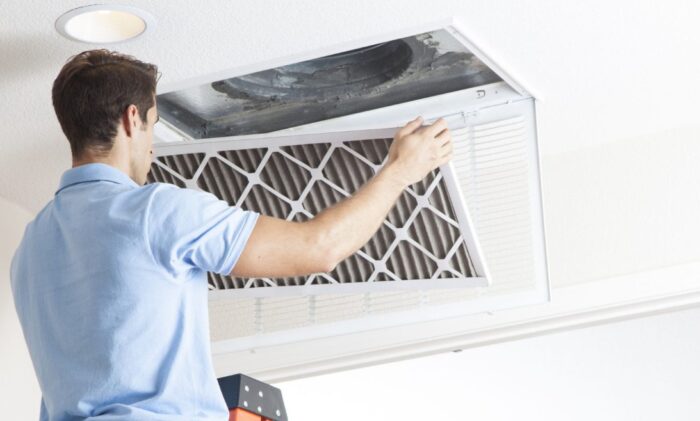
This is one of the most important filters in a house, especially if you have pets, smoke or suffer from asthma or allergies. Cleaning HVAC filters is an important maintenance task to ensure the efficient operation of your HVAC and maintain indoor air quality.
Tip: Before you clean it, you’ll need to determine the filter type. HVAC filters come in different types, including disposable filters and reusable filters. Refer to your HVAC’s user manual or consult with a professional to identify the type of filter installed in your system.
How to Clean Disposable HVAC Filters?
- When cleaning disposable filters, first turn off the HVAC and ensure that the system isn’t actively running.
- Locate the filter compartment in your HVAC. In most cases, it’s found near the return air duct or in the blower compartment.
- Carefully remove the disposable filter from its slot. Inspect it for dust, debris, or visible dirt accumulation. If it’s lightly soiled, you can proceed with cleaning. Otherwise, it’s recommended to replace it with a new one.
- If the filter is washable, you can vacuum it using a soft brush attachment to remove loose debris. Alternatively, you can rinse it under lukewarm water, using gentle water pressure to remove dirt and contaminants.
- Let the filter have a thorough dry before putting it back in place.
- Finally, reinstall the filter once it’s dry into the filter compartment, ensuring it fits securely and in the correct orientation. Follow the arrows or markings on the filter for proper airflow direction.
How to Clean Reusable HVAC Filters?
- If you’re cleaning reusable filters, again, first, turn off the HVAC.
- Locate the filter compartment and carefully remove the reusable filter from its slot.
- Depending on the type of reusable filter, you can clean it by either vacuuming with a soft brush attachment or using warm soapy water. It’s recommended to follow the manufacturer’s instructions for cleaning to ensure proper maintenance.
- If you’re using soapy water, rinse the filter thoroughly to remove any residue.
- Allow it to air dry completely before reinstalling it into the filter compartment, ensuring it fits securely and in the correct orientation.
- The frequency of cleaning HVAC filters will depend on several factors, such as the type of filter, household occupancy, indoor air quality, and the presence of pets or smokers.
As a general guideline, disposable filters should be checked monthly and replaced or cleaned as necessary.
Reusable filters may have longer cleaning intervals, typically every 2 to 3 months, but this can vary based on the factors mentioned above. Consult the manufacturer’s instructions for further direction.
Why Should You Clean HVAC Filters?
Several things can happen if you neglect regularly cleaning. A dirty or clogged HVAC filter restricts airflow, forcing the HVAC to work harder to heat or cool your home. This could result in an inefficient use of resources and more energy expended.
Besides that, inadequate airflow caused by a dirty filter can result in the HVAC overheating. Over time, this can lead to malfunctions, increased wear and tear on components, and potential system breakdowns. A dirty filter will also fail to effectively capture and trap airborne particles such as dust, pollen, pet dander, and allergens. This can lead to poor indoor air quality, exacerbating allergies and respiratory issues for occupants.
Lastly, a clogged filter forces the HVAC to work harder, consuming more energy and leading to higher utility bills
Refrigerator Filters
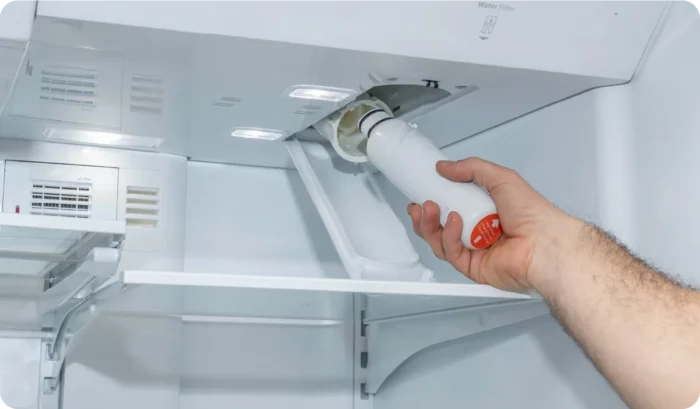
Cleaning refrigerator filters is an essential maintenance task to ensure optimal performance and prevent issues with your refrigerator.
To clean them, first, you’ll need to determine the filter type. Refrigerators may have different types of filters, such as water filters or air filters. Identify the specific filter type in your refrigerator by referring to the user manual or contacting the manufacturer.
How to Clean Water Filters on a Fridge?
- If you have a water filter, check the filter status.
- Most refrigerator water filters have indicators or alerts that indicate when they need to be replaced. Refer to the filter’s documentation or the refrigerator display to check the filter’s status.
- Before proceeding with the cleaning process, it’s important to turn off the water supply to the refrigerator. Consult the user manual to find out how to perform this task.
- Locate the water filter compartment, which is usually inside the refrigerator or in the grille at the bottom and follow the manufacturer’s instructions to remove the filter.
- If your water filter is labelled as reusable, you can clean it by rinsing it under warm water and using a soft brush, if necessary, to gently scrub away any debris or residue.
- Finally, reinstall the filter back into its compartment. Ensure it is aligned accurately and firmly attached.
How to Clean Air Filters on a Fridge?
- If you’re dealing with an air filter cleaning, first locate it. It’s usually at the back, inside the refrigerator compartment, or in the vent area. Refer to the owner’s manual of your refrigerator to determine the exact spot.
- The air filter could either be reusable, depending on the model, or require replacement. If it’s reusable, carefully remove it from its housing. If the air filter is reusable, you can clean it by rinsing it under warm water or using a vacuum cleaner with a brush attachment to remove dust and debris. Read and adhere to the cleaning guidelines specified by the manufacturer.
- After cleaning, allow the filter to air dry completely and reinstall it back.
The frequency of cleaning refrigerator filters can vary depending on usage and environmental factors. Water filters generally need to be replaced every six months, although some may have longer or shorter lifespans. Air filters typically require cleaning every three to six months, but this can vary based on the refrigerator model and usage. Consult the manufacturer’s instructions for more precise advice.
Why Should You Clean Fridge Filters?
There are several consequences if you forget to do that frequently. First, over time, filters can become clogged with contaminants, affecting their ability to effectively filter water or air. This can result in impurities entering the water supply or reduced air quality inside the refrigerator. If the water filter isn’t cleaned or replaced regularly, it may lose its effectiveness in removing impurities, leading to a negative impact on the taste, odour, and quality of the dispensed water and ice.
A dirty air filter can also obstruct the airflow inside the refrigerator, causing the cooling system to work harder and less efficiently. This can result in inadequate cooling, inconsistent temperatures, and potential strain on the compressor.
Lastly, when the refrigerator’s cooling system is compromised due to a dirty air filter, it consumes more energy to maintain the desired temperature. This can cause electricity bills to increase eventually.
Vacuum Cleaner Filters
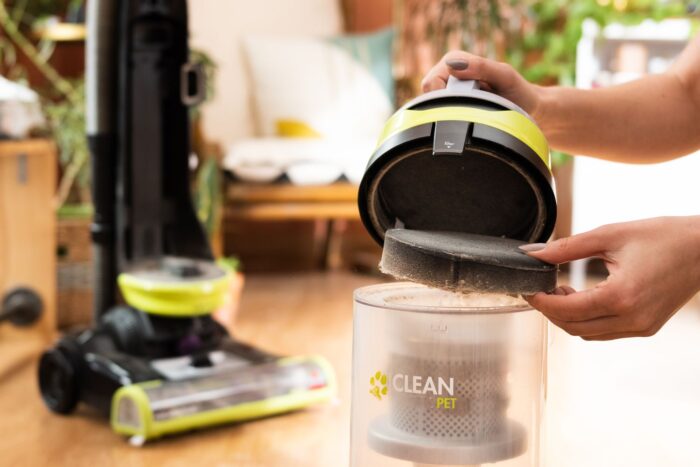
It’s recommended to never let vacuum cleaner filters or the bags fill to their maximum capacity before cleaning them. It’s best to replace them once they’re two-thirds full. Cleaning vacuum cleaner filters is crucial for maintaining the suction power and overall performance of your vacuum.
When cleaning one, first, check the type. Vacuum cleaners can have different types of filters, such as foam filters, HEPA filters, or cloth filters. Refer to your vacuum cleaner’s user manual to determine the specific filter type in your machine.
Afterwards, check the user manual to locate the foam filter in your vacuum cleaner. It is usually found near the dust collection compartment or in the airflow path.
How to Clean Foam Vacuum Filters?
- Take the foam filter outside or over a garbage bin and tap it gently to remove loose dust and debris. You can also use a soft brush to brush off the dirt.
- Rinse the foam filter under lukewarm water. Avoid using hot water as it can damage the filter.
- Squeeze and rinse until the water runs clear and all dirt is removed.
- Allow the foam filter to air dry completely before reinserting it back into the vacuum cleaner. Ensure the area is totally dry to avoid the development of mould or mildew.
How to Clean HEPA Vacuum Filters?
- If you have HEPA filters and cloth filters, first locate them in your vacuum cleaner and then follow the user manual instructions for removing the filter.
- Take the filter outside or over a garbage bin and gently shake it to remove loose dust and debris.
- Use a soft brush or cloth to wipe off any remaining dirt.
- Some HEPA and cloth filters are washable, while others are not. Refer to the manufacturer’s guidelines or the user manual to determine if the filter is washable.
- If the filter is able to be cleaned, use lukewarm water to rinse it. Squeeze or rinse gently until the water runs clear. Let the filter dry out completely in the air.
- If the filter cannot be cleaned, follow the manufacturer’s instructions for replacing it.
The frequency of cleaning vacuum cleaner filters depends on usage and the type of filter. As a general guideline, foam filters should be cleaned every month, while HEPA and cloth filters may need cleaning every 3 to 6 months. However, it’s important to refer to your vacuum cleaner’s user manual for specific cleaning recommendations.
Why Should You Clean Vacuum Filters?
If you neglect to clean them frequently, they can reduce your vacuum’s suction power. When filters are clogged with dirt and debris, airflow is restricted, leading to reduced suction power.
This can result in inefficient cleaning and leave behind dirt and debris on surfaces. A clogged filter can cause the vacuum cleaner’s motor to work harder, leading to overheating. Over time, this can result in motor damage and potentially require costly repairs or replacement.
Besides that, when vacuum cleaner filters are dirty and not cleaned regularly, they cannot effectively trap dust, allergens, and other particles. This can result in poorer indoor air quality as these particles are released back into the air while vacuuming.
Lastly, a vacuum cleaner with clogged filters requires more energy to maintain suction, leading to increased energy consumption and higher electricity bills.
Conclusion
In conclusion, the filters in our homes play a crucial role in maintaining clean and healthy living spaces.
While we diligently clean some of the obvious filters, like those in vacuum cleaners, it is easy to overlook other commonly forgotten ones, such as refrigerator water filters and HVAC filters.
Neglecting these can lead to poor air quality, reduced appliance efficiency, and potentially harmful contaminants entering our bodies.
To ensure a truly pristine environment for ourselves and our loved ones, it is essential to incorporate regular filter maintenance into our cleaning routines.
Make sure to mark your calendar for filter replacements or set reminders on your phone – this small step can make a world of difference.














